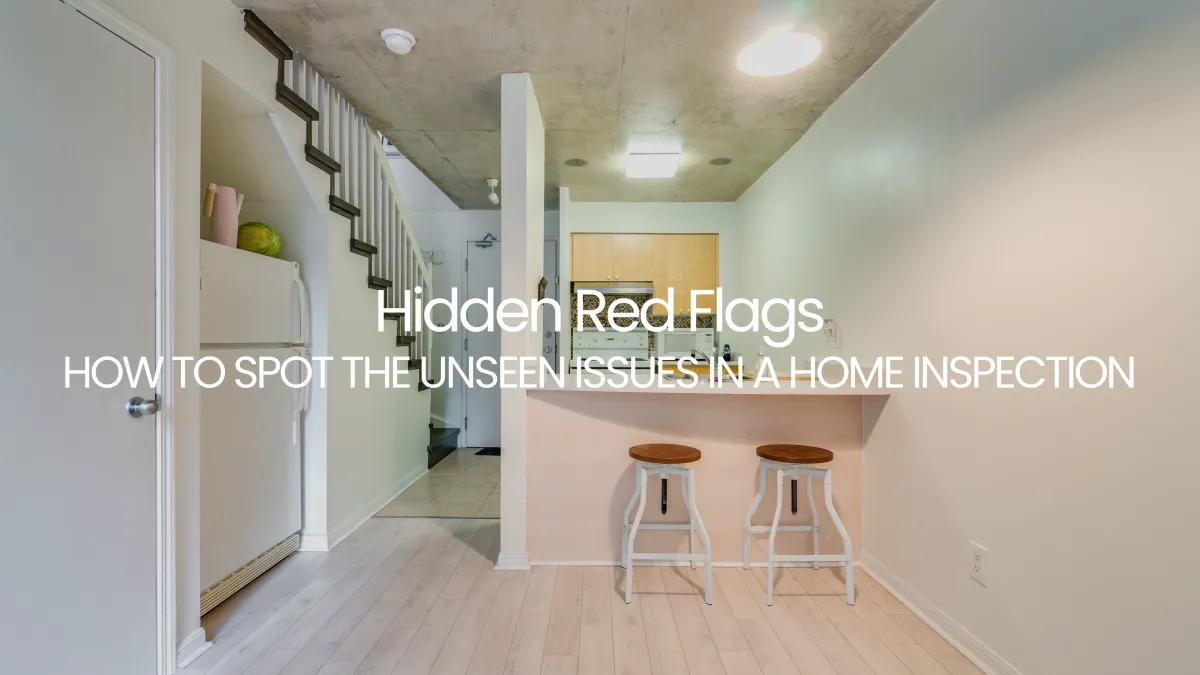
Hidden Red Flags: How to Spot the Unseen Issues in a Home Inspection
Buying a house is a big deal, especially if you are moving from a condo in Toronto to a house in the suburbs. One key step in this process is the home inspection. This blog will help you catch those hidden red flags, understand what to look for, and give you expert tips for a seamless house inspection.
10 Red Flags to Watch Out for During a House Inspection
1. Foundation Cracks
Foundation cracks can be a big problem. Small cracks may be normal, but large or zig-zag cracks can mean serious foundation issues. If you see these, it's crucial to get a structural engineer's opinion.
2. Water Damage
Water stains or soft spots in walls, ceilings, and floors can indicate current or past water leaks. This might lead to mold, which is a health hazard and can be costly to fix.
3. Old or Damaged Roof
An old or worn-out roof can lead to leaks and water damage inside the house. Look for missing shingles, sagging areas, or water spots on the ceiling.
4. Faulty Wiring
Old or faulty electrical wiring is not just inconvenient; it's a fire hazard. Check for flickering lights, buzzing sounds from outlets, or outdated fuse boxes.
5. Plumbing Problems
Check for leaky faucets, running toilets, or slow drains. Rusty pipes or low water pressure can indicate bigger plumbing issues.
6. Inadequate Ventilation
Proper ventilation prevents moisture buildup, which can lead to mold. Ensure bathrooms and kitchens have exhaust fans, and that the attic has proper ventilation.
7. Pests
Signs of pests, like droppings or chewed wires, indicate an infestation. Look for holes in the walls, sounds from the attic, or insect wings near windows.
8. Poor Drainage
Water should drain away from the house. Poor drainage can lead to foundation problems or flooding. Check the yard for standing water or wet spots.
9. Cracking or Peeling Paint
While not always serious, cracking or peeling paint can indicate moisture problems. It can also mean poor maintenance, suggesting other hidden issues.
10. Asbestos or Lead Paint
Older homes may have asbestos insulation or lead-based paint, both of which are health hazards. If the house was built before 1980, it's crucial to get materials tested.
The Ultimate House Inspection Checklist: Don't Miss These Crucial Areas
Exterior of the House
Foundation: Look for visible cracks, uneven floors, or sticky doors and windows.
Roof: Check for missing, cracked, or curling shingles, and look in the attic for water stains.
Siding: Ensure it's intact without cracks, holes, or rot.
Gutters and Downspouts: They should be secure and direct water away from the foundation.
Windows and Doors: Check for drafts, cracks, or difficulty opening and closing.
Interior of the House
Basement: Look for signs of water damage, mold, or pests.
Attic: Check for proper insulation and ventilation, as well as signs of roof leaks.
Walls, Ceilings, and Floors: Look for cracks, sagging, or water stains.
Kitchen and Bathrooms: Check under sinks and behind appliances for leaks or water damage.
HVAC System: Ensure heating and cooling systems are functional and the filters are clean.
Systems
Electrical: Look for exposed wiring, outdated fuse boxes, and ensure outlets and switches function properly.
Plumbing: Run faucets and showers, check water pressure, and inspect pipes for rust or leaks.
Insulation: Ensure it’s adequate in the attic, walls, and floors.
Expert Tips for a Seamless House Inspection: What the Pros Look For
1. Hire a Qualified Inspector
Start with a professional home inspector who is licensed and experienced. Ask for recommendations from friends or real estate agents, and check online reviews.
2. Attend the Inspection
Be present during the inspection. This allows you to ask questions, see issues first-hand, and get a better understanding of the property.
3. Take Notes and Photos
Document everything the inspector points out. Notes and photos will help you remember details and make informed decisions later.
4. Don’t Rush the Process
A thorough inspection takes time. Avoid inspectors who rush through the process, as they may miss important issues.
5. Ask for a Detailed Report
The inspection report should be detailed and include photos. It should cover all visible and accessible areas of the house.
6. Don’t Hesitate to Ask Questions
If you don’t understand something in the report, ask. A good inspector will explain issues fully and help you understand the risks.
7. Consider Specialist Inspections
If the general inspection reveals potential issues, you might need specialist inspections. For example, if there’s evidence of pests, hire a pest control expert. If there are structural concerns, consult a structural engineer.
8. Negotiate Repairs or Price Reductions
Use the inspection report to negotiate with the seller. Depending on the issues found, you can ask for repairs, a reduction in the purchase price, or even decide to walk away from the deal.
9. Follow Up on Repairs
If the seller agrees to make repairs, ensure they use qualified professionals and provide receipts or warranties for the work done.
10. Use the Report for Future Maintenance
Even after moving in, the inspection report can serve as a valuable guide for future maintenance. It helps you plan and budget for necessary repairs and upkeep.
Conclusion
A thorough home inspection is vital when buying a house, especially when moving from a condo in Toronto to a suburban home. By knowing what red flags to watch out for, having a detailed checklist, and following expert tips, you can ensure a smooth inspection process. This will help you make an informed decision, avoid costly repairs, and find the perfect home for you and your family.


Royal Lepage Signature Realty
(647) 492-1880
495 Wellington St. W. #100 Toronto, ON M5V 1E9
Copyright 2024 Q Real Estate Group - All rights reserved. Toronto Regional Real Estate Board (TRREB) assumes no responsibility for the accuracy of any information shown. The information provided herein must only be used by consumers that have a bona fide interest in the purchase, sale or lease of real estate and may not be used for any commercial purpose or any other purpose.
Privacy Policy | Cookie Policy | Property Listings | Sitemap | Accessibility
The data relating to real estate on this web site comes in part from the Internet Data Exchange (IDX) program of the Toronto Real Estate Board. The information herein is believed to be accurate and timely, but no warranty as such is expressed or implied. The information provided herein must only be used by consumers that have a bona fide interest in the purchase, sale, or lease of real estate and may not be used for any commercial purpose or any other purpose. IDX information is provided exclusively for consumers’ personal, non-commercial use and that it may not be used for any purpose other than to identify prospective properties consumers may be interested in purchasing. Information deemed reliable but not guaranteed to be accurate. Listing information updated daily.
